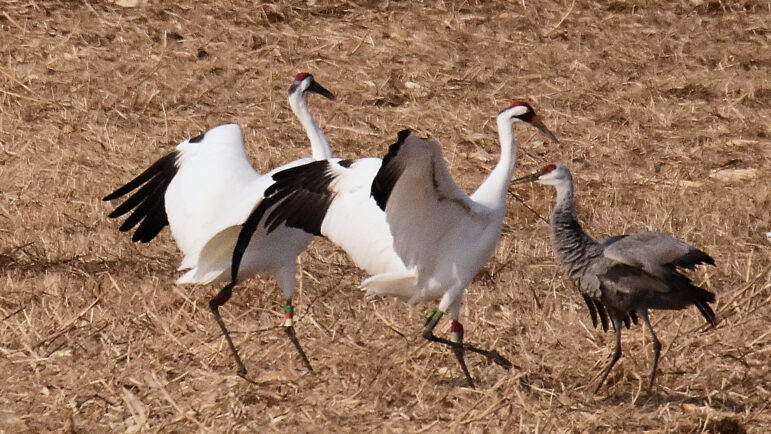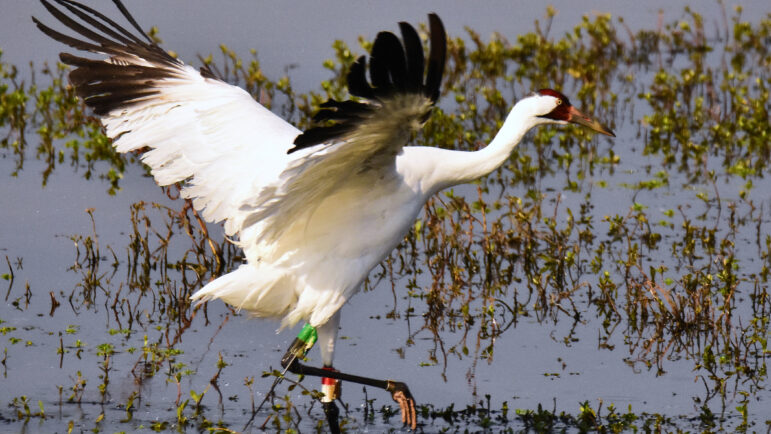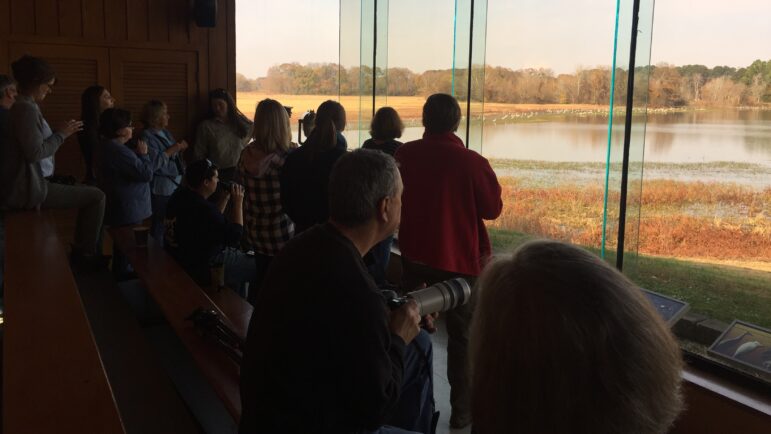Endangered Whooping Cranes Are Coming Back
Two endangered whooping cranes come in for a landing at Wheeler National Wildlife Refuge in Decatur, Alabama.
A couple extra wild birds in a creek doesn’t seem too important … until you realize that not long ago, there were barely 20 of them in the world. Whooping cranes are the tallest bird in America and they can live into their thirties, but that didn’t keep them from near-extinction. Now, though, thanks to decades of cooperation, they’re making a comeback. And you can see it — and definitely hear it — in Alabama.
Dozens of birdwatchers walk along a path near a marshy creek in Wheeler National Wildlife Refuge in Decatur. There are signs saying “quiet please,” but hundreds of cranes mock that plea with raucous cries.
Most of the symphony comes from sandhill cranes. But dotting the brown flock are a few endangered whooping cranes. Compared to the sandhill cranes, they’re fewer but bigger and brighter.

Amber Wilson of the International Crane Foundation says, “You’ll definitely be able to spot out the whooping cranes because they are about my height. They’re huge. They could look me in the eye, five feet tall. They have black on their wing tips. They’re bright white birds, and they also have that red patch on their heads.”

Wilson’s organization has been breeding whooping cranes since the 1970s. And this past summer in Wisconsin, a small wild flock the foundation helped start produced two new chicks. One is already at Wheeler. Two more wild whooping cranes might not sound like a lot, but, “two is very significant because to my knowledge, this is the first time that this has actually happened in this population. So these birds are going to grow up and they’re going to have amazing genetics, and they’re going to start having more chicks,” Wilson says. “We’re really happy about it.”
That’s partly because these birds had all but disappeared due to hunting and habitat destruction. In the 1940s there were barely 20 left in the wild. But people began trying to save them through captive breeding, land preservation, and rearing chicks with hand puppets. Biologists even taught the birds to migrate between Wisconsin and the Southeast by guiding them with small planes. And it wasn’t the planes the birds were following — it was the pilot wearing a full-body crane suit.
Anna Turkett, a lorikeet specialist at the Birmingham Zoo, understands the devotion.
“The cranes are really important to me because I feel like they’re a national treasure that’s in our backyard,” she says. “They’re such a comeback story and they’re so rare. And in Alabama, we don’t get those large beautiful animals. It’s so great to have them here in a place that’s so close to home.”

Wilson credits cooperation from conservation groups, government agencies, donors, and volunteers. And she credits the birds themselves:
“To have roughly 500 in the wild right now is extraordinary. These birds are actually really tough. They’ve found that some avian diseases that other birds are more susceptible to, cranes are not as susceptible to.”

In recent years, 20 or 30 whooping cranes have wintered in Wheeler. This year, conservationists hope that might rise to 40. If that happens, they say, it’s a good sign not just for the cranes but for the other species in those ecosystems.

Auburn fires coach Hugh Freeze following 12th loss in his last 15 SEC games
The 56-year-old Freeze failed to fix Auburn’s offensive issues in three years on the Plains, scoring 24 or fewer points in 17 of his 22 league games. He also ended up on the wrong end of too many close matchups, including twice this season thanks partly to questionable calls.
In a ‘disheartening’ era, the nation’s former top mining regulator speaks out
Joe Pizarchik, who led the federal Office of Surface Mining Reclamation and Enforcement from 2009 to 2017, says Alabama’s move in the wake of a fatal 2024 home explosion increases risks to residents living atop “gassy” coal mines.
‘It’s like feeling the arms of your creator just wrapped around you’: a visit to a special healing Shabbat
Members of Temple Emanu-El in Birmingham gathered recently for their traditional Friday Shabbat service. But this particular service was different, as could be seen by all the people dressed in their finest pink.
Space Command is coming to Huntsville. What might that mean for first-time homebuyers
While Huntsville has been a more affordable market than other growing cities, what’s it been like for those looking for their first home?
Colorado says relocation of Space Command to Alabama is ‘punishment’ for mail-in voting
The litigation announced by Colorado Attorney General Phil Weiser asks a federal judge to block the move as unconstitutional.
Breaking down Alabama’s CHOOSE Act
It’s been a year since Alabama legislators passed the CHOOSE Act allowing families to apply for state funds to use towards homeschool expenses and tuition for participating private schools. The Alabama Daily News’ education reporter Trisha Powell Crain has been diving into how the funds are being used. WBHM’s Andrew Gelderman sat down with her to talk about what we’re seeing so far.









